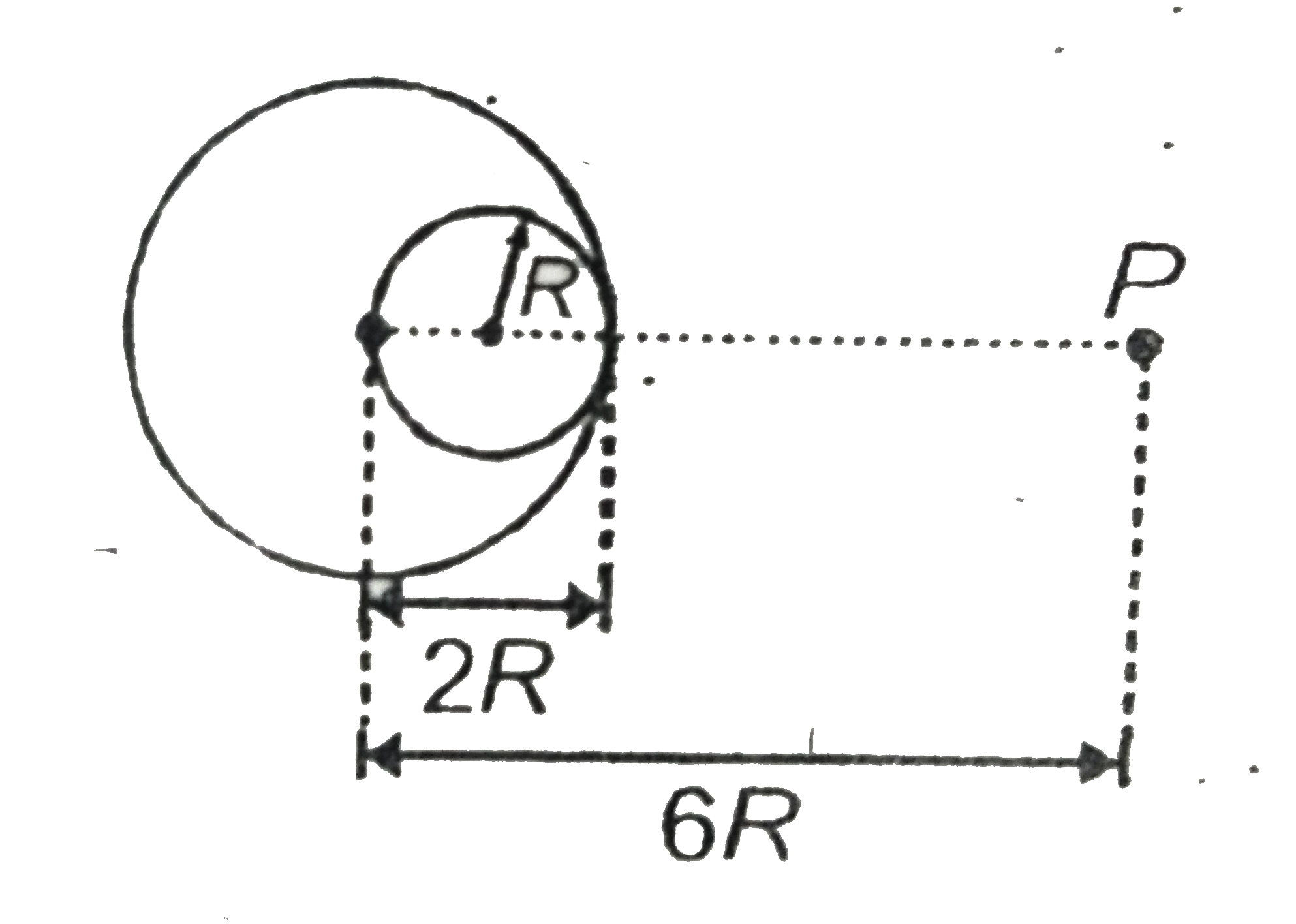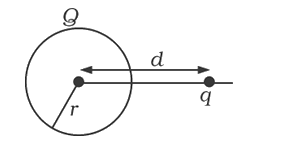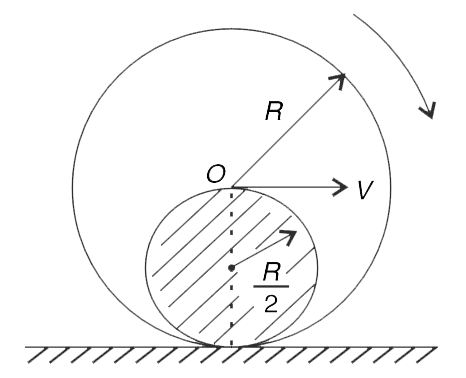A conducting sphere of radius R2 has a spherical cavity of radius R1 which is non concentric with the sphere. A point charge q1 is placed at a distance r from the centre of the cavity. For this arrangement, answer the following questions.
Electric potential at the centre of the cavity will be :
zero
kq1r−kq1R1
kq1r−kq1R1+Kq1R2
None of these
The correct Answer is:C
To solve the problem regarding the electric potential at the center of the cavity of a conducting sphere with a point charge placed inside, we can follow these steps:
1. Understanding the Setup:
- We have a conducting sphere of radius R2 with a spherical cavity of radius R1 that is not concentric with the sphere.
- A point charge q1 is placed at a distance r from the center of the cavity.
2. Induced Charge on the Inner Surface:
- When the point charge q1 is placed inside the cavity, it induces a charge of −q1 on the inner surface of the cavity. This is due to the property of conductors, which states that the electric field inside a conductor in electrostatic equilibrium must be zero.
3. Charge on the Outer Surface:
- The total charge of the conducting sphere remains neutral. Therefore, if −q1 is induced on the inner surface, a charge of +q1 will appear on the outer surface of the conducting sphere.
4. Electric Potential at the Center of the Cavity:
- The electric potential V at a point due to a point charge is given by the formula:
V=kqr
where k is Coulomb's constant, q is the charge, and r is the distance from the charge to the point where the potential is being calculated.
5. Calculating Contributions to Potential:
- The potential at the center of the cavity due to the point charge q1 located at distance r from the center of the cavity is:
Vq1=kq1r
- The potential due to the induced charge −q1 on the inner surface of the cavity (which is uniformly distributed) is:
V−q1=−kq1R1
(where R1 is the radius of the cavity).
- The potential due to the charge +q1 on the outer surface of the conducting sphere at the center of the cavity (which is at a distance R2 from the outer surface) is:
V+q1=kq1R2
6. Total Electric Potential:
- The total electric potential V at the center of the cavity is the sum of the potentials due to all the charges:
V=Vq1+V−q1+V+q1
V=kq1r−kq1R1+kq1R2
7. Final Expression:
- Therefore, the electric potential at the center of the cavity can be expressed as:
V=kq1(1r−1R1+1R2)
- We have a conducting sphere of radius R2 with a spherical cavity of radius R1 that is not concentric with the sphere.
- A point charge q1 is placed at a distance r from the center of the cavity.
- When the point charge q1 is placed inside the cavity, it induces a charge of −q1 on the inner surface of the cavity. This is due to the property of conductors, which states that the electric field inside a conductor in electrostatic equilibrium must be zero.
- The total charge of the conducting sphere remains neutral. Therefore, if −q1 is induced on the inner surface, a charge of +q1 will appear on the outer surface of the conducting sphere.
- The electric potential V at a point due to a point charge is given by the formula:
V=kqr
where k is Coulomb's constant, q is the charge, and r is the distance from the charge to the point where the potential is being calculated.
- The potential at the center of the cavity due to the point charge q1 located at distance r from the center of the cavity is:
Vq1=kq1r
- The potential due to the induced charge −q1 on the inner surface of the cavity (which is uniformly distributed) is:
V−q1=−kq1R1
(where R1 is the radius of the cavity).
- The potential due to the charge +q1 on the outer surface of the conducting sphere at the center of the cavity (which is at a distance R2 from the outer surface) is:
V+q1=kq1R2
- The total electric potential V at the center of the cavity is the sum of the potentials due to all the charges:
V=Vq1+V−q1+V+q1
V=kq1r−kq1R1+kq1R2
- Therefore, the electric potential at the center of the cavity can be expressed as:
V=kq1(1r−1R1+1R2)
Similar Questions
A sphere of radius 2R and mas M has a spherical cavity of radius R as shown in the figure. Find the value of gravitational field at a point P at a distance of 6R from centre of the sphere.

View SolutionA solid conducting sphere of radius r is having a charge of Q and point charge q is a distance d from the centre of sphere as shown. The electric potential at the centre of the solid sphere is :

View Solution
Knowledge Check
A conducting sphere of radius R2 has a spherical cavity of radius R1 which is non concentric with the sphere. A point charge q1 is placed at a distance r from the centre of the cavity. For this arrangement, answer the following questions.
Electric field (magnitude only) at the center of the cavity will be :AzeroBKq1r2CKq1r2−Kq1R21DNone of theseA conducting sphere of radius R2 has a spherical cavity of radius R1 which is non concentric with the sphere. A point charge q1 is placed at a distance r from the centre of the cavity. For this arrangement, answer the following questions.
If q1 is shifted to the centre of the cavity, then: (choose the correct alternative)Aelectric field in the region outside sphere may changeBelectric potential in the region outside sphere may changeCelectrostatic energy stored in the system may changeDelectric potential of sphere may changeA point charge q is placed at a distance of r from the centre O of an uncharged spherical shell of inner radius R and outer radius 2R. The electric potential at the centre of the shell will be
 Aq4πε0(1r−12R)Bq4πε0rCq4πε0(1r+12R)DNone of these
Aq4πε0(1r−12R)Bq4πε0rCq4πε0(1r+12R)DNone of these
A point charge Q is placed inside a conducting spherical shell of inner radius 3R and outer radius 5R at a distance R from the centre of the shell. The electric potential at the centre of the shell will be
View SolutionA uniform sphere of radius R has a spherical cavity of radius R2 (see figure). Mass of the sphere with cavity is M. The sphere is rolling without sliding on a rough horizontal floor [the line joining the centre of sphere to the centre of the cavity remains in vertical plane]. When the centre of the cavity is at lowest position, the centre of the sphere has horizontal velocity V. Find:
(a) The kinetic energy of the sphere at this moment.
(b) The velocity of the centre of mass at this moment.
(c) The maximum permissible value of V ( in the position shown ) which allows the sphere to roll without bouncing

View SolutionThere is a conductor with cavity of radius R as shown in figure. A point charge Q is placed at R/2 distance from centre of cavity.
A point P is at r distance from centre of conductor. Then,

View SolutionA solid sphere of mass M and radius R has a spherical cavity of radius R/2 such that the centre of cavity is at a distance R/2 from the centre of the sphere. A point mass m is placed inside the cavity at a distance R/4 from the centre of sphere. The gravitational force on mass m is
View SolutionA conducting sphere of radius b has a spherical cavity with its centre displaced by 'a' from centre of sphere O1. A point charged q is placed at the centre of cavity O2. Q charge is given to conducting sphere and charge q0 is placed at P, a distance c from centre O1. Further O1,O2 and P are collinear

View Solution